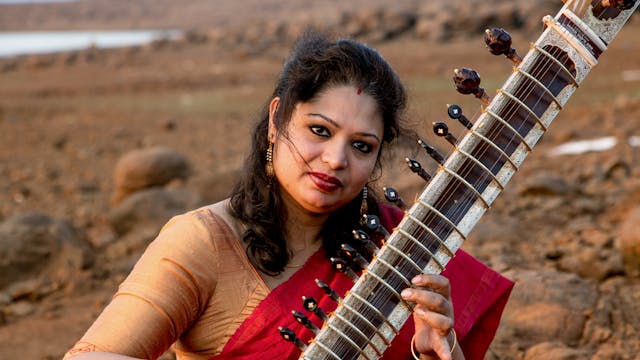Dr Prabha Atre | Raag Bhairavi
Women in Indian Classical Music
•
7m 47s
Recorded for Darbar on 21 Sep 2014, at London’s Southbank Centre
- Dr Prabha Atre (khayal)
- Bharat Bhushan Goswami (sarangi)
- Ajay Joglekar (harmonium)
- Sanju Sahai (tabla)
- Chetna Banawat (khayal & tanpura)
- Gunwant Kaur (surmandal)
- Priya Parkash (tanpura)
Raag Bhairavi; Thaat: Bhairavi; Samay: Morning
Prabha Atre, now in her 80s, demonstrates that age does not have to be a barrier to exceptional musicianship. Here she leads a khayal group through Bhairavi.
Learn more about the music:
Prabha Atre did not originally play to pursue a musical career. But aged eight, her mother was ill and took a friend’s suggestion to take classical singing lessons to help her feel better. The young Prabha was inspired by overhearing the lessons, and studied with Kirana gharana gurus including Sureshbabu Mane and Hirabai Badodekar. She also credits Amir Khan and Bade Ghulam Ali Khan with influencing her gayaki. She has also received degrees in both science and law, and earned a PhD in the use of sargam in Indian classical. Now in her 80s, she continues to captivate audiences with a refined yet often exuberant style.
Bhairavi is often described as the ‘queen of ragas’. It takes its name from the Hindu goddess of destruction, and conjures versatile moods. To some it can evoke ‘awe, terror, and chaos’; to others ‘a pleasant sobering atmosphere of love and piety’. It is played at sunrise, or alternatively as the final piece in a concert. Understanding the raga in depth is crucial to Hindustani learning - bansuri master Rupak Kulkarni recounts the approach of his guru Hariprasad Chaurasia: “Guruji taught me Raag Bhairavi for five years. When I complained about the repetition, he said: ‘You have to practice Bhairavi until your last breath’. That is what made me realize what swarabhyas [the study of notes] means”.
It is based on the form SrgmPdnS - all swaras [notes] are komal [flattened] except Sa, Ma, and Pa, like the Western Phrygian scale or Carnatic Raga Hanumatodi. The vadi and samvadi [king and queen notes] are typically taken to be Ma and Sa. The raga commonly takes a versatile mishra (‘mixed’) form - all 12 notes are allowed, thus injecting some comparatively rare chromaticism into Hindustani music. Its flexibility is unmatched in the raga pantheon.
Subscribe to the Darbar Player to access the full, uncut performance.
Up Next in Women in Indian Classical Music
-
Sahana Banerjee | Raag Yaman
Recorded on location in Mulshi, Maharashtra, India in 2015.
Musician:
- Sahana Banerjee (sitar)Sahana Banerjee plays Alaap and Jod in Raag Yaman
Raag Yaman; Thaat: Kalyan; Samay: EveningSahana Banerjee explores Raag Yaman in this 8 minute 44 second presentation of Darbar’s On Location series...
-
Indrani Mukherjee | Director's Cut
Recorded at Darbar Festival 2017, on 12th November, at the Lilian Bayliss Studio, at Sadler's Wells Theatre, London.
Musicians:
- Indrani Mukherjee (khayal)
- Gurdain Rayatt (tabla)
- Milind Kulkarni (harmonium)
- Seetal Dhadyalla (tanpura)Music Pieces:
- Raag Lalit; Thaat: Poorvi; Samay: E... -
Shubha Mudgal | Tilang
Raags Performed:
- Raag TilangMusicians :
- Shubha Mudgal (khayal)
- Aneesh Pradhan (tabla)
- Sudhur Nayak (harmonium)
- Mudhulika Mistry (tanpura)
- Gunwant Kaur (tanpura)Shubha Mudgal, one of India’s most revered vocalists, is known for her deep, sonorous voice and expressive artistry that ...



